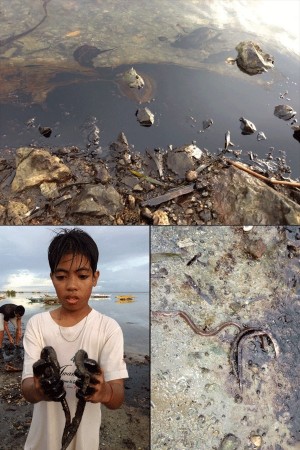
A boy (bottom left) holds two oil-coated bagasi, salt water eels, which thrives in Cordova town, Mactan Island Cebu. Oil spill is seen in the waters near the shore of Mactan Isldan. Photo from the Office of Cebu Rep. Luigi Quisumbing
CEBU CITY, Philippines — Authorities said Sunday they were unable to stop fuel leaking from a ferry that sank, as oil spread to coastal villages, fishing grounds and mangroves more than five kilometers away.
The St. Thomas Aquinas ferry sank on Friday night after colliding with a cargo ship just outside the port in Cebu, the Philippines’ second biggest city, leaving at least 38 people dead.
Authorities were focused Sunday on trying to find 82 people missing and believed inside the ferry, about 30 meters under water, but the leaking oil added a new front to the disaster response.
“You can see it coming out of the sunken vessel. It is bunker fuel and it is black,” Cebu coastguard commander Weniel Azcuna told AFP.
“It has affected a lot of shorelines here in Cebu and (the neighboring island of) Mactan.”
He said there was about 120,000 liters of bunker fuel, and divers had been unable to reach the source of the leak.
Among the areas affected were Lapu-Lapu City and Cordova town on Mactan island, and Talisay city in Cebu, which all host popular beach resorts.
Cordova also has protected mangrove areas while Talisay has a thriving fishing industry.
At Cordova, roots of mangroves were coated in black oil at low tide, according to an AFP reporter who visited the area, which is more than five kilometers from where the ferry sank.
Herons and egrets waded amid shallow water that had a rainbow sheen of oil.
Azcuna said that because the hole could not be plugged, the coastguard and a company contracted by the ferry operator were spraying a chemical dispersant to try and break it up.
He could not say how much of the fuel had leaked out already.
An official with the ferry operator told a television station the company intended to bring in foreign experts who could safely pump out the remaining fuel.